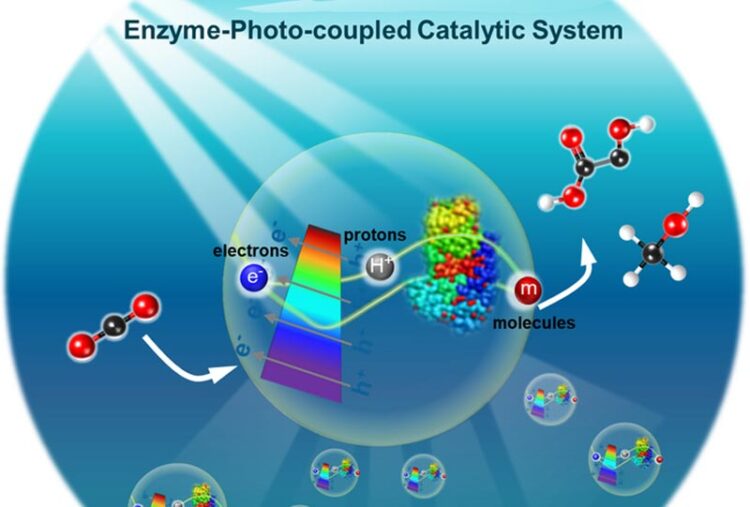Molecule-electron-proton transfer in enzyme-photo-coupled catalytic system

Enzyme-Photo-coupled Catalytic System (EPCS) is an emerging platform technology for green biomanufacturing that uses photocatalysts to capture solar energy and subsequently drives the enzyme catalysis. The essence of mass/energy exchange in EPCS could be depicted as molecule transfer, electron transfer and proton transfer. The synergistic intensification of molecule-electron-proton transfer is of vital importance in fortifying the mass/energy exchange in EPCS.
Credit: Chinese Journal of Catalysis
The harmonious coexistence between the human society and the nature has prompted the rapid development of advanced manufacturing. Typically, green biomanufacturing, which uses renewable resources as raw materials and enzymes or microorganisms as catalysts to produce target chemicals, has been considered to be highly consistent with The Twelve Principles of Green Chemistry.
Specifically, enzyme-based green biomanufacturing has been extensively applied for many industrial fields such as food, pharmaceutical, chemicals, etc. Reduction reactions are most commonly employed in enzyme-based biomanufacturing processes. The continuous supply of reducing energy is therefore essential. Introducing fossil energy is the frequently used strategy, which does not only cause the increase of production costs, but also lead to the generation of oxidation by-products that are difficult to separate. Therefore, using cheap and renewable energy (such solar energy) to afford sufficient reducing energy is urgently required for achieving sustainable green biomanufacturing.
Natural photosynthesis offers an ideal prototype of green biomanufacturing, during which green plants absorb sunlight and split H2O into O2, electrons and protons. These electrons and protons are used to drive the synthesis of energy-rich biological reductants, such as NADPH and ATP, which are further involved in the Calvin-Benson cycle to accomplish the CO2 fixation.
Enzyme-Photo-coupled Catalytic System (EPCS) is a typical solar-driven biomanufacturing process. EPCS, as a new model to mimic natural photosynthesis, can use photocatalysts to capture solar energy and further drive the enzyme catalysis for the production of various chemicals. However, the solar-to-chemical conversion efficiency of EPCS is far below theoretical upper limit for the photosynthesis in nature. Conventional EPCS focuses on the development of photocatalysts or the matching between photocatalysts and enzymes, while never offers guidelines for the construction of EPCS from the perspective of molecule-electron-proton transfer.
Recently, a research team led by Prof. Zhongyi Jiang from Tianjin University, China proposed a new strategy to strengthen the mass/energy coupling in EPCS by coordinating and optimizing the “New Three Transfers” (molecule, electron and proton transfer), thus improving the solar-to-chemical conversion efficiency. Natural photosynthesis provides an ideal model with well-matched molecule-electron-proton transfer, which would help to shed light on the molecule-electron-proton transfer phenomenon in EPCS. This review aimed to implant the molecule-electron-proton transfer from natural photosynthesis to EPCS. In addition, the current status and grand challenges in realizing the synergistic intensification of all three transfers in EPCS were analyzed, and some perspectives on research and development of EPCS were offered. The review was published in Chinese Journal of Catalysis (DOI: 10.1016/S1872-2067(22)64154-8).
About the Journal
Chinese Journal of Catalysis is co-sponsored by Dalian Institute of Chemical Physics, Chinese Academy of Sciences and Chinese Chemical Society, and it is currently published by Elsevier group. This monthly journal publishes in English timely contributions of original and rigorously reviewed manuscripts covering all areas of catalysis. The journal publishes Reviews, Accounts, Communications, Articles, Highlights, Perspectives, and Viewpoints of highly scientific values that help understanding and defining of new concepts in both fundamental issues and practical applications of catalysis. Chinese Journal of Catalysis ranks among the top two journals in Applied Chemistry with a current SCI impact factor of 12.92. The Editors-in-Chief are Profs. Can Li and Tao Zhang.
At Elsevier http://www.journals.elsevier.com/chinese-journal-of-catalysis
Manuscript submission https://mc03.manuscriptcentral.com/cjcatal
Journal: Chinese Journal of Catalysis
Article Title: Molecule-electron-proton transfer in enzyme-photo-coupled catalytic system
Article Publication Date: 2-Dec-2022
Media Contact
Fan He
Dalian Institute of Chemical Physics, Chinese Academy Sciences
hef197@dicp.ac.cn
Office: 86-411-843-79240
All latest news from the category: Life Sciences and Chemistry
Articles and reports from the Life Sciences and chemistry area deal with applied and basic research into modern biology, chemistry and human medicine.
Valuable information can be found on a range of life sciences fields including bacteriology, biochemistry, bionics, bioinformatics, biophysics, biotechnology, genetics, geobotany, human biology, marine biology, microbiology, molecular biology, cellular biology, zoology, bioinorganic chemistry, microchemistry and environmental chemistry.
Newest articles
Faster, more energy-efficient way to manufacture an industrially important chemical
Zirconium combined with silicon nitride enhances the conversion of propane — present in natural gas — needed to create in-demand plastic, polypropylene. Polypropylene is a common type of plastic found…

Energy planning in Ghana as a role model for the world
Improving the resilience of energy systems in the Global South. What criteria should we use to better plan for resilient energy systems? How do socio-economic, technical and climate change related…

Artificial blood vessels could improve heart bypass outcomes
Artificial blood vessels could improve heart bypass outcomes. 3D-printed blood vessels, which closely mimic the properties of human veins, could transform the treatment of cardiovascular diseases. Strong, flexible, gel-like tubes…




















